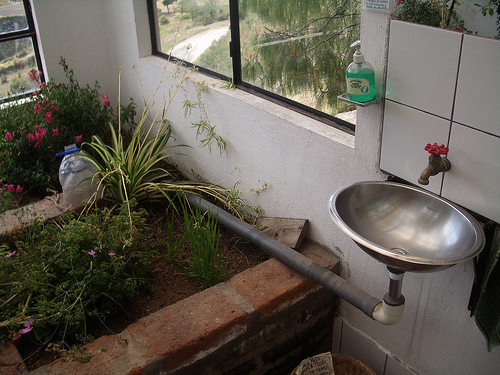Waste and nutrients
Today’s Daily Shoot assignment was:
Illustrate an aspect of modern culture today. Make a photo that communicates the feeling of abandoned or discarded.
I thought that was a leading assignment. It naturally suggests a negative emotional response. My first mental picture was of an abandoned person or a broken child’s toy left in the gutter. I didn’t want to go down that route, so I went outside and took a picture of our composting bin.
Compost is made up of discarded material, but that material is far from useless. It is destined to live a second life as nutrients for the soil. In permaculture design, that is the way all waste is viewed: as a valuable nutrient. I was in Ecuador a few years ago and stayed at a permaculture lodge, the Black Sheep Inn. One of my favourite features of the lodge was its composting toilet:
[ ](http://www.flickr.com/photos/33199451@N06/sets/72157624989107165/with/5059313343/ “”){.tt-flickr.tt-flickr-Thumbnail}
](http://www.flickr.com/photos/33199451@N06/sets/72157624989107165/with/5059313343/ “”){.tt-flickr.tt-flickr-Thumbnail}
There are plenty of unpleasant composting loos, but this one was well designed, fragrant and a pleasure to spend time in. There was a book hanging from a piece of string by the throne: Sym Van Der Ryn’s The Toilet Papers
East and West developed very different attitudes and practices in relation to the human body and its processes. In China and Japan, “night soil” has been scrupulously collected for centuries to fertilize the fields. A nineteenth century visitor to Japan tells us that in Hiroshima, in the renting of poorer tenement houses, if three persons occupied a room together the sewage paid the rent of one, and if five occupied the same room, no rent was charged. Farmers vied with each other to build the most beautiful roadside privies in the hope of attracting the favors of travellers who needed to relieve themselves.
Sitting on this throne, reading these words was the moment I first started to appreciate what permaculture meant – and also how it could be extended beyond food production, farming and gardening, to be a broader approach to life and work. When we design products and services to work in harmony with the systems they’re a part of, they can sustain themselves. They’re more productive for less effort. They’re non-toxic.
Far from the ploughed fields, sitting in offices discussing marketing campaigns or system design, it’s useful to borrow this lens to examine our work. What are the waste products in your system? How can they be turned into nutrients?
